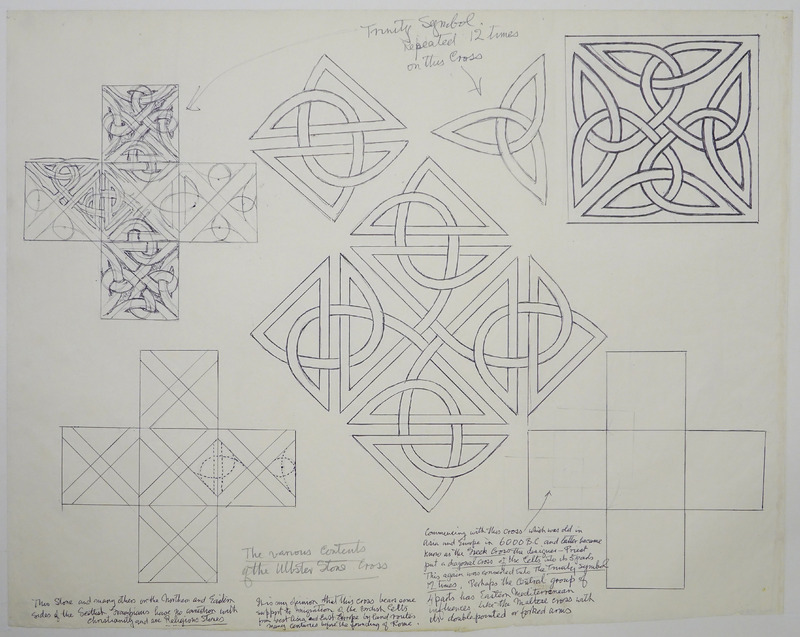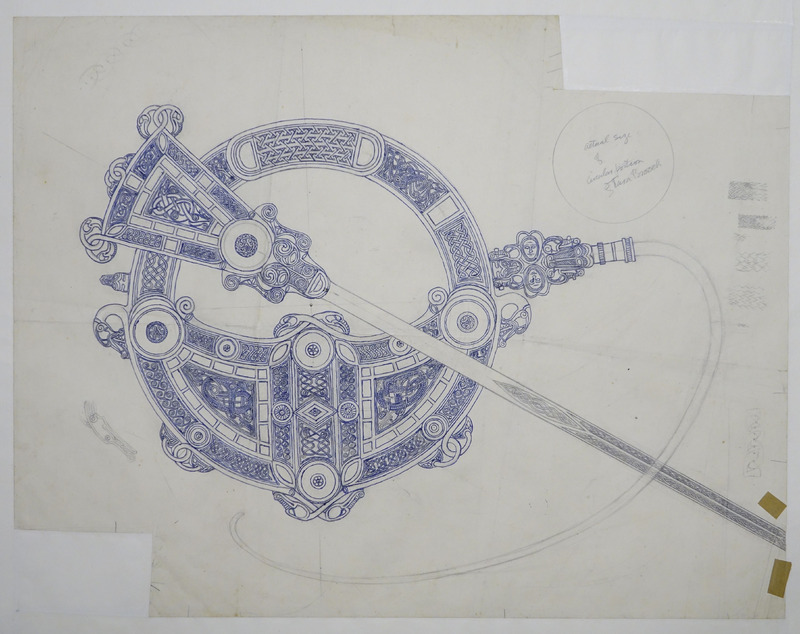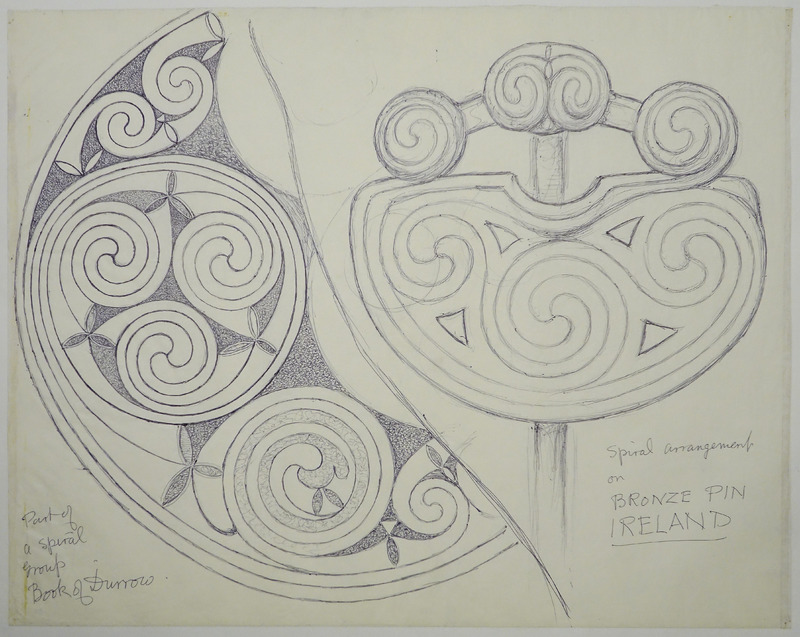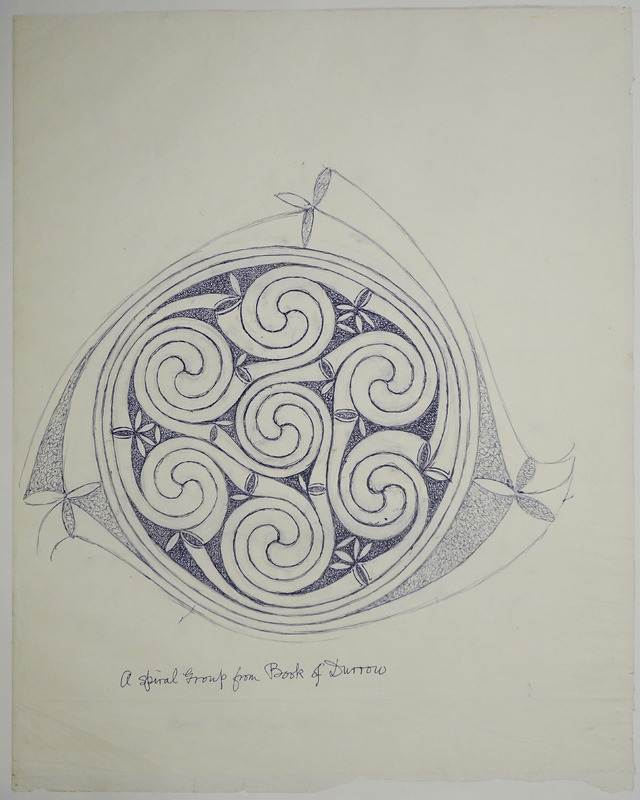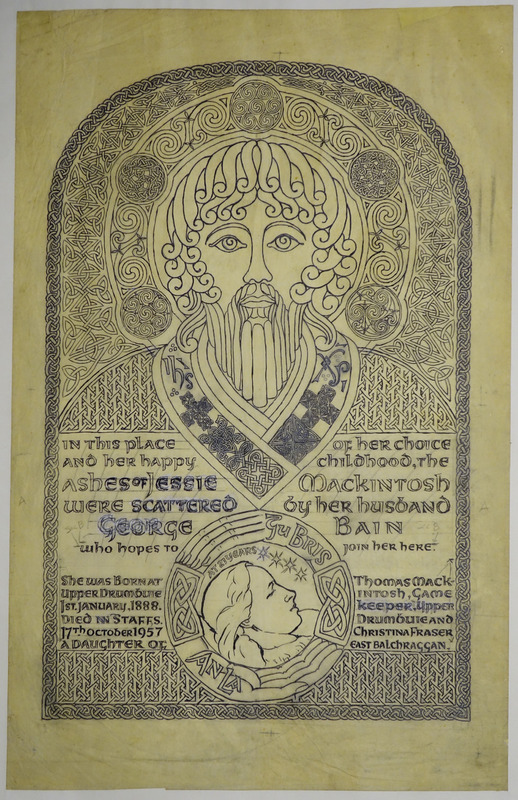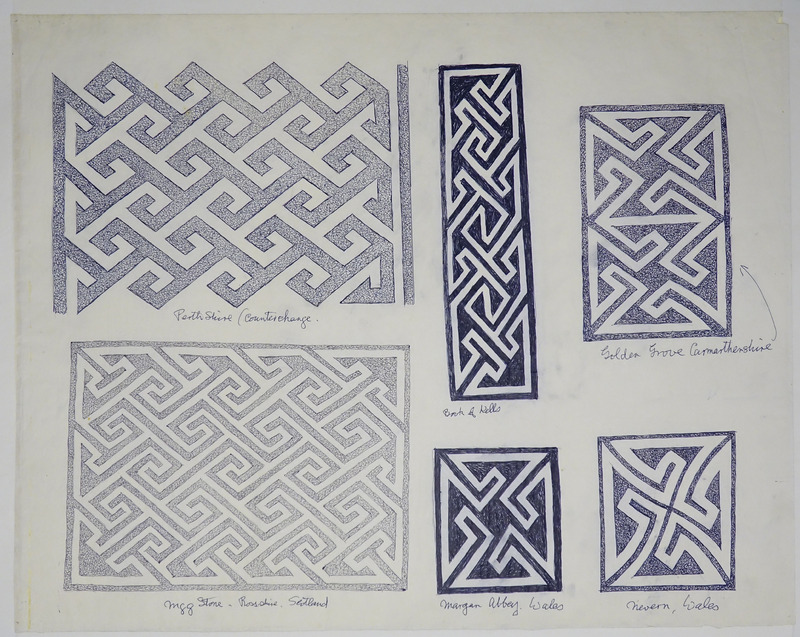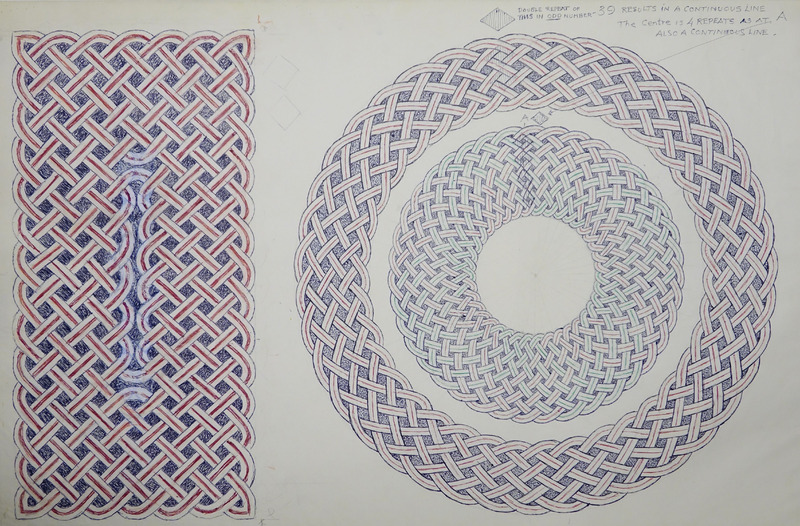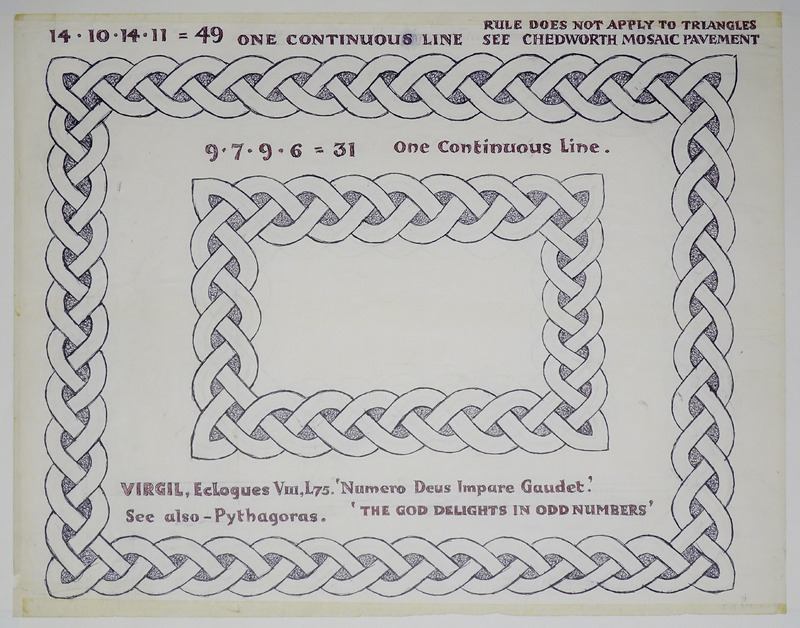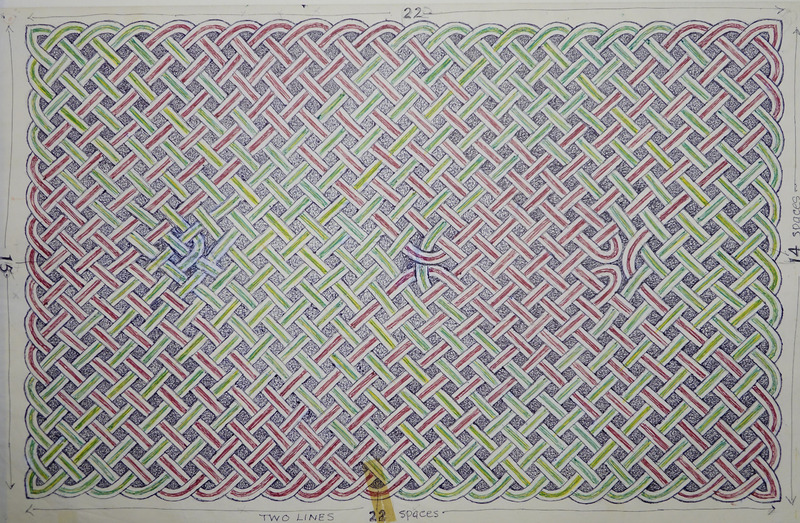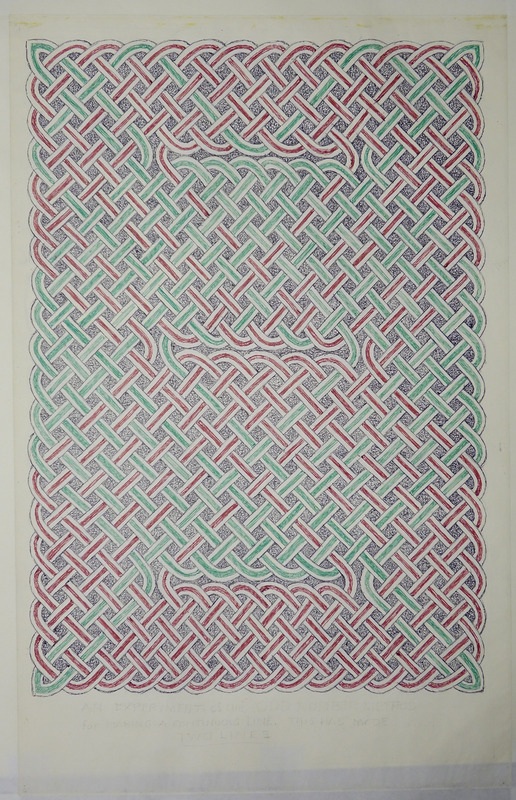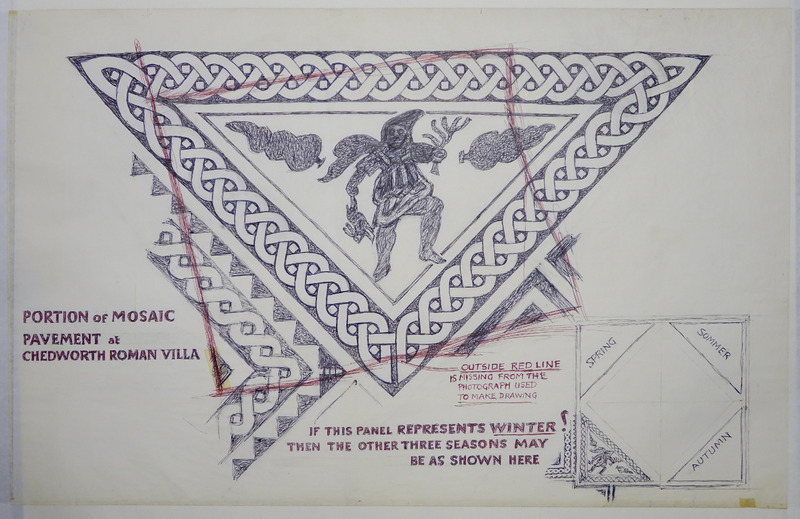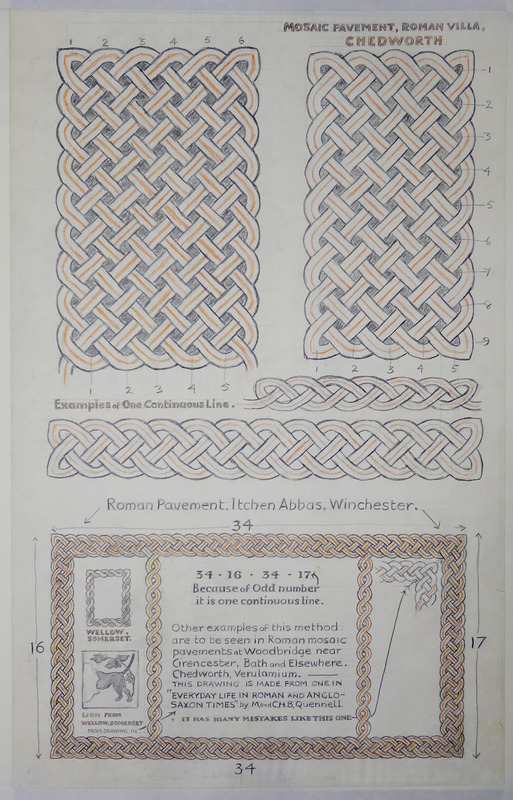Trinity symbol
'These stones and many others on the northern and eastern sides of the Scottish Grampians have no connection with Christianity and are Religious Stones'.
'It is my opinion that this cross bears some support to immigration of the British Celts from West Asia and East Europe by land routs many centuries before the founding of Rome'.
'Commencing with the cross which was old in Asia and Europe in 6000 BC and latter became known as the 'Greek Cross' the designer-Priest put a diagonal cross of the Celts into its 5 parts. This again was converted into the Trinity Symbol 12 times, perhaps the central group of 4 parts has Eastern Mediterranean influences, like the Maltese Cross with it's double pointed or forked arms'.
- George Bain
Tara Brooch
George Bain's detailed drawing of the Tara Brooch.
The Tara Brooch is a Celtic brooch of about 700 AD generally considered to be the most impressive of over 50 elaborate Irish brooches to have been discovered.
The brooch, named after the Hill of Tara, seat of the legendary High Kings of Ireland, is 7 inches long, made of cast and gilt silver and is elaborately decorated on both faces. The front is ornamented with a series of exceptionally fine gold filigree panels depicting animal and abstract motifs that are separated by studs of glass, enamel and amber.
Although the brooch is named after the Hill of Tara, traditionally seen as the seat of the High Kings of Ireland, the Tara Brooch has no connection to either the Hill of Tara or the High Kings of Ireland. The brooch was supposedly found in August 1850 on the beach at Bettystown, near Laytown, County Meath, some 50 km (30 mi) north of Dublin. The finder, a peasant woman (or her two sons), claimed to have found it in a box buried in the sand, though many think it was in fact found inland and she claimed it was found at the beach to avoid a legal claim by the landowner. It was sold to a dealer and then to the Dublin jeweller George Waterhouse who was already producing Celtic Revival jewellery and who renamed it the "Tara Brooch" to make it more appealing.
Book of Durrow
This drawing from George Bain compares part of a spiral group from the Book of Durrow with a spiral arrangement on an Bronze Pin found in Ireland.
The Book of Durrow is a medieval illuminated manuscript gospel book in the Insular art style. The place of creation may perhaps have been Durrow Abbey in Ireland or a monastery in Northumbria in northeastern England (where the monastery at Lindisfarne would be the likely candidate) or perhaps Iona Abbey in western Scotland -- the place of origin has been debated by historians for decades without a consensus emerging. The Book of Durrow was certainly at Durrow Abbey by 916. Today it is in the library at Trinity College, Dublin.
Book of Durrow is the oldest extant complete illuminated Insular gospel book, for example predating the Book of Kells by over a century. The text includes the Gospels of Matthew, Mark, Luke and John, plus several pieces of prefatory matter and canon tables. Its pages measure 245 by 145 mm and there are 248 vellum folios.
Book of Durrow
'A Spiral Group from Book of Durrow'. - George Bain.
The illumination of the book shows especially well the varied origins of the Insular style, and has been a focus for the intense art-historical discussion of the issue. One thing that is clear is that the artist was unused to representing the human figure; his main attempt, the Man symbol for Matthew, has been described as a "walking buckle". Apart from Anglo-Saxon metalwork, and Coptic and Syriac manuscript illustrations, the figure has been compared to a bronze figure with a panel of geometric enamel on his trunk, from a bucket found in Norway. The artist is clearly far more used to depicting animals, and these have close relationships to continental eagle fibulae for the eagle, Pictish Stones and English metalwork for the "shoulder spirals" on the lion and ox.
'The beauty of nature's spirals was probably observed by man's earliest ancestors, for the shell was also a container of his staple food'. - George Bain, Celtic Art, The Methods of Construction.
Commemorative Plaque
'In this place of her choice and her happy childhood, the ashes of Jessie Mackintosh were scattered by her husband George Bain, who hopes to join her here'.
The sudden death of his (George Bain's) wife in 1957 was a tremendous grief to him. In her memory he designed a bronze plaque which marks the resting place of her scattered ashes in the Highlands'.
'George Bain died in Codsall, Staffordshire on 25 March 1968. His ashes were scattered, as he wishes, in the same place as those of his wife, Jessie, beside their joint memorial'.
- George Bain, Master of Celtic Art
- Susan E Seright
Sutton Hoo
Drawing of the 'probable method of construction' of the Sutton Hoe (Hoo) Enamelled bronze buckle.
The Sutton Hoo belt-buckle, early 7th century. Found in the Sutton Hoo ship-burial mound.
Gold, hollow box buckel, that opens at the back on a hinge beneath the loop. A locking system, involving a complex system of sliders and internal rods which fit into slotted fixings, enables it to close securely.
In early Anglo-Saxon England, buckles used to fasten waist belts were a means of expressing a man’s wealth and status. The type of metal used and the fineness of decoration were key factors. This spectacular gold buckle from the Sutton Hoo ship burial shows that the person commemorated there was of great importance.
Key Patterns
Drawing of examples of Key Patterns (repeated vertical and horizontal lines) from:
- Perthshire.
- Nigg Stone.
- Book of Kells.
- Margam Abbey, Wales.
- Nevern, Wales.
- Golden Grove, Carmarthenshire, Wales.
Know here as the Key Pattern, or a meander or meandros (Greek: Μαίανδρος) it is a decorative border constructed from a continuous line, shaped into a repeated motif. Such a design is also called the Greek fret or Greek key design, although these are modern designations. On the one hand, the name "meander" recalls the twisting and turning path of the Maeander River in Asia Minor, and on the other hand, as Karl Kerenyi pointed out, "the meander is the figure of a labyrinth in linear form". Among some Italians, these patterns are known as Greek Lines.
'J. Romeilly Allen was of the opinion that the essential difference between the classical Key patterns and those used by the Christian Celts of Britain and Ireland, consisted in the introduction of diagonal lines by the latter.' - George Bain, Celtic Art, The Methods of Construction.
Celtic Knots
According to artist George Bain, Religion and Pagan laws had the greatest influence on the art form of Celtic knots, playing an important role in there design.
The interlacing of human form and Celtic knots evolved from laws forbidding drawing portraits of human figures as this was tantamount to copying a work of the creator, “God the Almighty,” explains Bain in his book Celtic Art. Similarly, it was forbidden to draw animals or plants. Angels and mythic creatures, on the other hand, were not of the earthly realm. And Saints had departed this realm. Thus, Celtic knot patterns were used to represent most of the human form, while heads, appendages and tails were often depicted using more life-like representations.
Celtic Knots
According to artist George Bain, Religion and Pagan laws had the greatest influence on the art form of Celtic knots, playing an important role in there design.
The interlacing of human form and Celtic knots evolved from laws forbidding drawing portraits of human figures as this was tantamount to copying a work of the creator, “God the Almighty,” explains Bain in his book Celtic Art. Similarly, it was forbidden to draw animals or plants. Angels and mythic creatures, on the other hand, were not of the earthly realm. And Saints had departed this realm. Thus, Celtic knot patterns were used to represent most of the human form, while heads, appendages and tails were often depicted using more life-like representations.
Chedworth Roman Villa
Chedworth Roman Villa is the remains of a large country house of the Roman period, in Gloucestershire.
The villa was discovered by accident in 1864, when a gamekeeper found fragments of paving and pottery.
The importance of these finds were recognised by James Farrer who uncovered most of the buildings now visible over a period of two years at the expense of the then owner, the Earl of Eldon.
Over a mile of walls survives and there are several fine mosaics (all mosaics are under cover to protect them from the elements).
Chedworth Roman Villa
Chedworth Roman Villa is the remains of a large country house of the Roman period, in Gloucestershire.
The villa was discovered by accident in 1864, when a gamekeeper found fragments of paving and pottery.
The importance of these finds were recognised by James Farrer who uncovered most of the buildings now visible over a period of two years at the expense of the then owner, the Earl of Eldon.
Over a mile of walls survives and there are several fine mosaics (all mosaics are under cover to protect them from the elements).
Chedworth Roman Villa
Chedworth Roman Villa is the remains of a large country house of the Roman period, in Gloucestershire.
The villa was discovered by accident in 1864, when a gamekeeper found fragments of paving and pottery.
The importance of these finds were recognised by James Farrer who uncovered most of the buildings now visible over a period of two years at the expense of the then owner, the Earl of Eldon.
Over a mile of walls survives and there are several fine mosaics (all mosaics are under cover toprotect them from the elements).
Itchen Abbas Roman Villa
Itchen Abbas is a village on the River Itchen about 4 miles (6.4 km) north-east of Winchester in Hampshire, England. The village is part of the Itchen Valley civil parish.
The villa was investigated in 1878 and 1879 when an area of approximately 18m by 15m was uncovered. Five rooms were uncovered, four of which were laid out around a possible courtyard. The four rooms around the courtyard contained mosaics; three of which had decorative panels.
